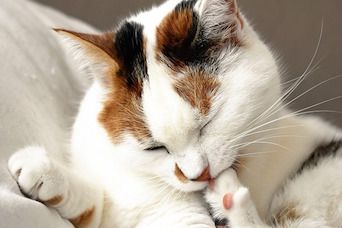Cats' Litter Box Preferences in Multicat Environments
A recent study confirms that cats prefer clean litter to dirty litter, with no difference between litter soiled by themselves or by another cat.

In a study recently published in Behavioural Processes, investigators assessed whether cats avoid litter boxes previously used by another cat. Their results confirm that cats prefer clean litter to dirty litter, with no difference between litter soiled by themselves or by another cat. The findings also suggest that the physical presence—but not the odor—of urine and feces affects litter box use.
Inappropriate elimination is the most common behavioral reason cats are given up to shelters, say the authors. “If the factors contributing to the exhibition of out-of-box elimination can be better understood, there is the potential to help reduce the number of cats being relinquished to and euthanized in shelters,” they write.
The study, funded by Nestlé Purina, included 29 domestic shorthair cats living at a Nestlé Purina facility. Cats spent a few hours each day in playgroups with other cats but were housed in single-cat enclosures with other cats within view. Litter boxes in the enclosures were filled with unscented clumping clay litter.
The investigators’ first objective was to determine if previous use of a litter box (litter containing urine and feces versus clean litter) affected cats’ litter box preferences. The cats uniformly preferred clean litter to dirty litter. When given a choice between litter boxes containing their own or another cat’s urine and feces, cats showed no preference between boxes.
The second objective was to find out whether litter box preference was affected by the odor, but not the physical presence, of another cat’s urine or feces. The researchers treated litter with a small volume of urine and/or liquefied feces sufficient to convey the odor without creating large litter clumps. An equal volume of distilled water was the control. They found that the odor of urine and/or feces had no effect on litter box preference.
The third objective was to assess the effects of physical/visual obstructions (urine clumps or fecal logs), but not odor, in the litter box. The investigators created odorless simulated urine clumps with saline and simulated fecal logs with unflavored gelatin molded into the appropriate shape. The control was clean litter. All cats except one preferred clean litter to litter containing simulated urine or feces. This preference increased as the number of faux urine clumps or fecal logs increased. When given a choice between a litter box with simulated urine clumps and one with simulated fecal logs, the cats chose to urinate and defecate in the box with the simulated fecal logs.
No cats eliminated outside a litter box during the course of the study. The investigators note that the nature of the study eliminated some potential causes of inappropriate elimination. The study cats were familiar with each other, all were neutered, intercat aggression was very rare, and the cats did not have to compete for litter box access.
“Based on the results of this study, there is no evidence cats were averse to sharing a litter box,” conclude the authors. “However, these findings reemphasize the importance of regular litter box maintenance as the key factor in promoting proper litter box use.”
Dr. Laurie Anne Walden received her doctorate in veterinary medicine from North Carolina State University. After an internship in small animal medicine and surgery at Auburn University, she returned to North Carolina, where she has been in small animal primary care practice for over 20 years. Dr. Walden is also a board-certified editor in the life sciences and owner of Walden Medical Writing, LLC. She works as a full-time freelance medical writer and editor and continues to see patients a few days each month.